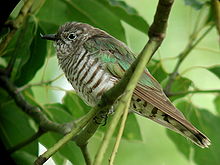Shining bronze cuckoo
| Shining bronze-cuckoo | |
|---|---|
 |
|
| In Queensland, Australia | |
| Scientific classification | |
| Kingdom: | Animalia |
| Phylum: | Chordata |
| Class: | Aves |
| Order: | Cuculiformes |
| Family: | Cuculidae |
| Genus: | Chrysococcyx |
| Species: | C. lucidus |
| Binomial name | |
|
Chrysococcyx lucidus (Gmelin, 1788) |
|
| Synonyms | |
|
Chalcites lucidus |
|
Chalcites lucidus
The shining bronze-cuckoo (Chrysococcyx lucidus) is a species of cuckoo in the family Cuculidae, found in Australia, Indonesia, New Caledonia, New Zealand, Papua New Guinea, Solomon Islands, and Vanuatu. It was previously also known as Chalcites lucidus.
It is the world’s smallest cuckoo, being only 15 to 17 centimetres (5.9 to 6.7 in) in length, and parasitises chiefly dome-shaped nests of various Gerygone species, having a range that largely corresponds with the distribution of that genus. It may also parasitise other Acanthizidae species, and is also the most southerly ranging brood parasitic bird species in the world, extending to 45°S in New Zealand.
The German naturalist Johann Friedrich Gmelin described the shining bronze-cuckoo in 1788 as Cuculus lucidus, from a specimen collected from Queen Charlotte Sound in New Zealand. John Latham described the golden bronze-cuckoo as Cuculus plagosus from New South Wales in 1801, and the two were classified as separate species for many years. However the two are now considered conspecific. Common names in New Zealand include pipiwharauroa and whistler.
Hard to spot and easier to hear, the shining bronze-cuckoo has metallic golden or coppery green upperparts and white cheeks and underparts barred with dark green. The female is similar with a more purplish sheen to the crown and nape and bronzer-tinged barring on the belly. The bill is black and the feet are black with yellow undersides.
The shining bronze-cuckoo is a summer visitor to Eastern Australia from the Cape York Peninsula in Queensland to South Australia's Eyre Peninsula and Kangaroo Island and Tasmania, as well as Western Australia from Carnarvon in the north to the southwest and east to Esperance. These winter in the Lessa Sunda Islands and New Guinea. New Zealand populations winter in the Solomon Islands and arrive in New Zealand from mid August, though they are not common until October. They spread out to Stewart and Chatham Islands and are found to an altitude of 4000 ft.
...
Wikipedia

